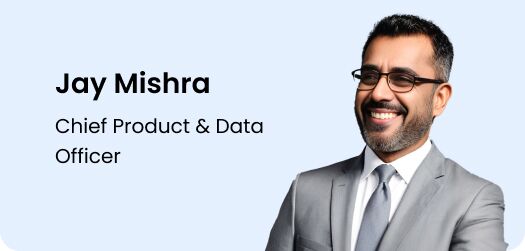Implementing a modern, integrated data architecture can help you break down data silos, which cause C-suite decision-makers to lose 12 hours a week. Furthermore, more than 60% of organizations agree that data silos represent a significant business challenge.
The solution is a data architecture that eliminates silos, and that’s where the data mesh vs. data fabric debate comes in. While both data architectures work to eliminate data silos, they differ in their approaches (more on that later). While both data mesh and data fabric approaches have their proponents, the question of which is better comes down to your organization’s unique data needs.
In this post, you’ll learn about data mesh and data fabric, their similarities and differences, the pros and cons of implementing either strategy, and how to choose between them.
Choose and Implement The Right Data Strategy with Astera
Leverage our data expertise to figure out the best data architecture for your organization.
Discuss your data strategy with us. What Is Data Mesh?
Data mesh was first presented as a concept by Zhamak Dehghani in 2019. It is a domain-oriented data architecture approach to decentralizing data analytics. Data mesh ensures the timely availability of data analytics to multiple teams, eliminating siloed data in the process.
The modern distributed approach moves away from monolithic applications and redistributes data ownership to domain-specific teams and users. This helps your teams retrieve, understand, manage, and utilize their data assets and stack (spread across domains as data microservices), empowering them to steer data-driven initiatives and innovation.
In other words, data mesh lets your teams treat data as a product. So, instead of facilitating data silo formation, you are empowering your domain-specific teams to take ownership and share their data, improving cross-functional collaboration and insight sharing.
Data Mesh: What Does It Need?
The following key principles guide the data mesh approach:
Decentralized Domain-focused Data Ownership
Instead of a centralized repository like a data lake or warehouse, data ownership will rest with your functional teams, such as marketing or sales. Since the teams are responsible for the lifecycle of their data assets, the data mesh approach fosters domain-specific expertise and accountability.
Treating Domain Data as a Product
The data mesh approach empowers your teams to treat data as a product. This approach involves delivering accessible, discoverable, high-quality data products to internal and external users. By taking on the role of data product owners, domain-specific teams apply product thinking to create reliable, well-documented, easy-to-use data products.
Self-serve Data Platform Design
The self-service data infrastructure in a data mesh allows your decentralized domains to share and use data products autonomously. This feature automates communication and insight-sharing so your teams can use, interpret, and analyze other domain-specific data sets with minimal technical expertise.
Unified Data Governance
Even with decentralized data ownership, the data mesh approach emphasizes the need for federated data governance, helping you implement shared standards, policies, and protocols across all your decentralized data domains. Shared data governance is crucial to ensuring data quality, security, and compliance without compromising on the flexibility afforded to your teams by the data mesh approach.
![Data Mesh vs. Data Fabric: Principles of Data Mesh Architecture]()
Data Mesh: Use Cases
- Customer Support: By adopting product thinking for data, your domain teams ensure their data is understandable for other teams, providing your marketing and support teams comprehensive information of the customer journey.
For instance, your support team can utilize relevant insights from different domains to reduce AHT (average handle time). Similarly, marketing can ensure their campaigns target the right demographics by analyzing sales and business development data.
- High-Quality Data Analytics: Your data analytics workloads receive high-quality data from multiple relevant business domains in data mesh architecture. This enables tailored BI dashboards to showcase operational performance, marketing insights, project management results, etc.
- Third-party Data Usage: Data mesh is handy in use cases requiring the incorporation of external datasets. You can administer third-party or public data as its own domain in the mesh, ensuring consistency with your internal domain-specific datasets.
What is Data Fabric?
Unlike the data mesh architecture, the data fabric approach is centralized. It presents an integrated and unified data management framework. Your organization can access, manage, and utilize data effectively with data fabric.
The centralized nature of the data fabric approach means you can access and work with your data, whether stored on-premises, in hybrid environments, or the cloud. You can achieve this by implementing an integrated and seamless access layer throughout your IT network.
One defining characteristic of the data fabric approach is its reliance on metadata to understand data lineage, structure, and value to your domain teams.
Data Fabric: What Does It Need?
The following technologies are crucial to implementing the data fabric architecture:
- Unified Data Layer: The data layer ensures secure and seamless data transportation and makes it accessible throughout your organization. The unified layer helps you ensure data quality and governance while enabling easy access and management.
- AI/ML-Based Automation & Integration: AI or ML (Machine Learning)- based algorithms help automate tasks such as data discovery, retrieval, structure recognition, and data analysis.
Automating tasks facilitates data integration activities, helping your organization manage high volumes of complex data from disparate sources.
- Intelligent Metadata Foundation: AI or ML (Machine Learning)- based algorithms help automate tasks such as data discovery, retrieval, structure recognition, and data analysis. Automating tasks facilitates data integration activities, helping your organization manage high volumes of complex data from disparate sources.
- API-Driven Front-End Interface: APIs serve as the technological backbone for the data fabric architecture. They help front-end users access data and insights to make agile and data-driven decisions.
![Data Fabric vs. Data Mesh: Data Fabric Architecture Principles]()
Data Fabric: Use Cases
Data fabric is a popular approach because it solves many problems in managing and analyzing data spread across multiple locations and systems. By offering a unified and integrated data environment, it streamlines data access management, improves data quality, and delivers data-driven insights in real-time.
- Holistic Data View: Suppose your organization is spread across multiple categories and handles data from disparate sources. Data fabric provides a unified data view, letting your teams access relevant insights while providing a holistic understanding of the business.
- OLTP Load Reduction: OLTP (Online Transaction Processing) databases are used in sectors such as retail and finance. Data fabric can help reduce the load on your OLTP databases by transferring analytical queries to the data fabric.
- Real-time insights: Implementing a data fabric can equip your organization with real-time insights, leading to data-driven decision-making across your organizational functions.
Data Mesh vs. Data Fabric: Key Considerations
Following are some considerations for when you’re choosing which architecture to implement to cater to your organization’s data management needs:
| | Data Mesh | Data Fabric |
| Scale and Complexity | Ideal for large-scale, complex data stacks where multiple teams work independently but share insights. | Ideal for organizations seeking a unified, centralized data platform, regardless of scale and complexity. |
| Organizational Structure | Teams have data ownership and management. Suitable for organizations with autonomy and cross-functional collaboration. | Organizations with a centralized IT and data management structure and hybrid data sources and storage. |
| Data Governance and Security | Data governance and security depend on domain teams’ data ownership and accountability. Enforcing policies across multiple departments is tricky. | Data governance and security are centralized. Enforcing policies across the organization is easy. |
| Implementation Time | Requires data ownership, product thinking & infrastructure for and from each team. It can take longer to implement. | With technically sound and centralized data engineering resources, it can be implemented in a shorter period. |
Pros & Cons of Implementing Each Data Strategy
While both approaches offer potential benefits, they also have certain downsides, primarily when implemented in isolation. Let’s look at the pros and cons of implementing each strategy:
Pros and Cons of Implementing Data Mesh
Pros
Data mesh’s decentralized nature lets you:
- Effectively scale your organization’s data management efforts,
- Distribute data responsibility and ownership across the domain teams,
- Eliminate any bottleneck and SPOF (single point of failure),
- And improve agility and responsiveness to changes in internal and external requirements.
Cons
Conversely, data mesh implementation can also lead to:
- Challenges in collaboration and coordination,
- Increased complexity in the data stack,
- Lack of consistency in data practices across domain teams,
- And overreliance on data standardization.
Pros and Cons of Implementing Data Fabric
Pros
Data fabric centralizes your data management efforts, which can help:
- Simplify data operations across the organization,
- Streamline data integration, access, processing, and storage,
- Enable consistent implementation of data governance, quality, and security policies,
- Make analytics and reporting workloads more efficient,
- And optimize resource utilization by reducing redundant data processing and storage.
Cons
On the flip side, the centralization of a data fabric can lead to:
- Formation of bottlenecks with high data volumes,
- Slow responsiveness to domain-specific changes,
- Dependency on a central team, compromising fast decision-making,
- Scalability challenges for larger enterprises with high data demands,
- Restrictions on innovation and experimentation due to low team autonomy,
- And complexity in handling diverse technologies and data sources.
Data Mesh vs. Data Fabric: How to choose your organization’s go-to data strategy?
To choose the right data architecture for your organization, you should:
- Evaluate your data needs. This includes your data strategy, data access and management needs, and the existing infrastructure.
- Consider the sociotechnical factors. These include your organization’s domain team structure, culture, and technical capabilities.
- Conduct a data maturity assessment. This can help you identify the weaknesses and strengths in your data ecosystem.
- Compare the different architectures. By this point, the choice would be between two or three options, such as data mesh vs. data fabric or data vault vs. data mesh.
It’s essential to conduct a proper evaluation along these steps before you make the final decision.
Still, data mesh may be a good choice if you want to:
- Decentralize your data platform,
- Empower your domain teams’ data ownership and management,
- Improve cross-functional collaboration and data sharing,
- Increase responsiveness to domain-specific challenges,
- Or comply with stringent data governance and quality protocols.
Data fabric may be a good choice if you want to:
- Eliminate data silos and obtain a unified data view,
- Manage multi-cloud or hybrid data environments,
- Utilize existing robust data integration capabilities,
- Or modernize a legacy data warehouse.
A Final Word
Data mesh and data fabric are both approaches that offer unique benefits if you’re looking to improve your organization’s data management and analytics. However, they differ in their key principles (centralized vs. decentralized). Since the potential upsides differ, too, the choice comes down to your organization’s data ecosystem.
Still, the solution isn’t necessarily a data mesh vs. data fabric debate. It can be a blended approach for your organization’s specific data architecture needs. The goal isn’t just to address your immediate data requirements and implement a system to help your organization navigate the dynamic data landscape. That’s where Astera comes in.
Astera can help you decide and implement the right data architecture for your organization. Astera’s automated no-code data stack lets your organization efficiently build, implement, manage, and scale your data ecosystem.
Request a personalized demo to learn how Astera can help your organization’s data architecture needs.
Authors:
![]() Raza Ahmed Khan
Raza Ahmed Khan
 Apr 29th | 11 AM PT
Apr 29th | 11 AM PT
